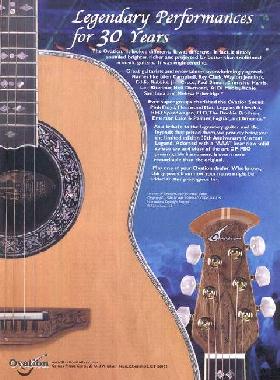
Joined:
August 2003
Posts: 4619
Location: SoCal | did a Google search for Bear Claw Spruce - used in Custom Legend 30th Anniv.
Used in some of the higher end Takamine and other guitars...other than visual, curious as whether there is any difference between the Sitka Spruce used in other than this model. Also, the term "Master" - we have different grades of the Sitka Spruce (i.e., AAA or AA.) Is Master a more select grade or another way to say AAA? |

Joined:
August 2003
Posts: 4619
Location: SoCal | Again, Ovation calls it "Master Grade Solid Bearclaw Spuce"
Search of OFC archives - see below responses; also links to several eBay guitars with "bear claw patterns." However, my CL 30th Anniv and pictures of others on eBay do not show a distinctive pattern of the "bear claw spruce" - not the same but somewhat similar to sitka spruce. Is this a different wood used, different thickness of top? Resonance?
------------------------
Paul Templeman Member Member # 30
posted June 29, 2002 05:07AM Spuce is graded according to colour, stiffness, weight, number of grain lines per inch (an AA grade top has 10-12 per inch on average) straightness & evenness of grain lines, lack of knots & shadow, accuracy of quarter-sawing, presence of "bearclaw" figure, and a few other factors. Generally luthiers look for tonewoods with a high strength to weight ratio I.E. a top that is light but stiff. The price of most traditional tonewoods including top grade Spruce is rocketing, but cheaper grades do not make poor sounding guitars. The sound of the guitar is not just in the wood, but how the luthier utilises it.
------------------------
Paul Templeman Member Member # 30
posted October 16, 2002 05:08AM
Bearclaw figure, also known as "hazelficte" is a pattern in the grain which can be seen sometimes in spruce. It's a rippling of the longitudinal fibres of the wood and is called Bearclaw because it can look like clawmarks. Unlike the figure in "tiger-stripe" or curly maple, the effect is random and assymetrical. Bearclaw Spruce carries a premium price because it usually occurs in older trees with tight grain structures which will produce very stiff, yet lightweight tops. It's also very pretty.Paul
------------------------
cwk2 Member Member # 7
posted October 16, 2002 08:17AM
Great explanation Paul. I usually say it looks like stretch marks and get funny looks from people.
We've seen all kinds of bearclaw. My 84 C-Series has pretty much matching inch long squiggles all over it. There have been some that look like birdseye and I've got a 87 C-Series that has 4 to 6 inch stripes through the grain but not very many of them. It makes nice guitars but it is much more random than maple patterns. W-2 |
 Bear Claw Spruce
Bear Claw Spruce


